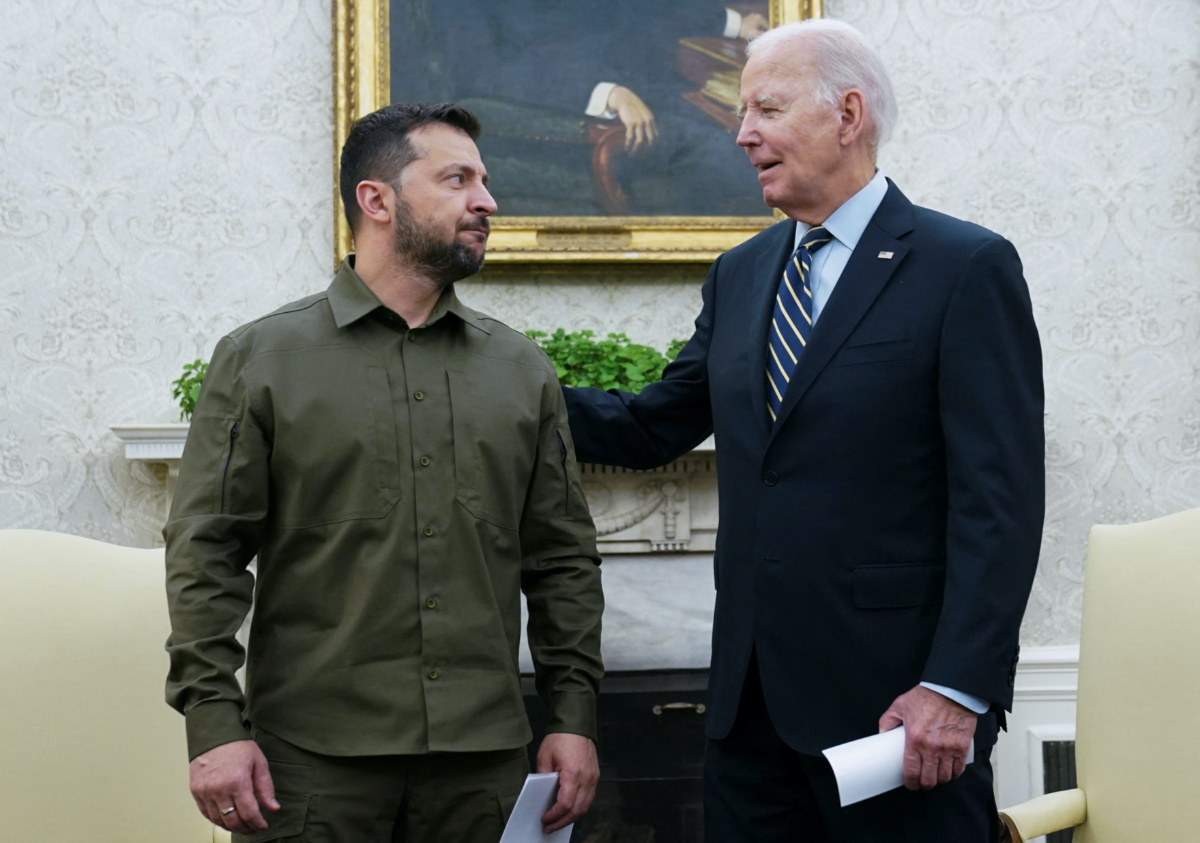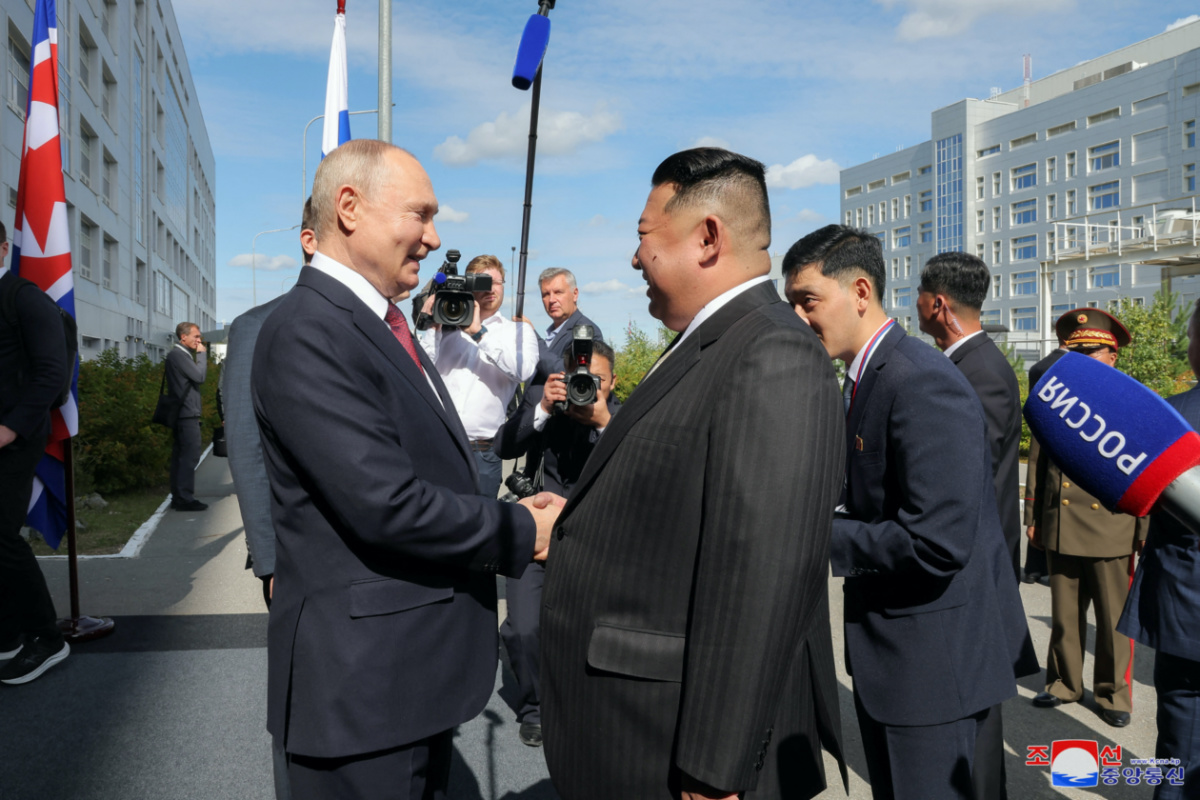
Expert on international security and weapons proliferation NOLAN FAHRENKOPF expresses – in an article first published on The Conversation – his concerns over the weakening of global cooperation to stop the spread of weapons and dangerous technology…
When Ukraine’s Volodymyr Zelenskyy met with President Joe Biden, on 21st September, 2023, the topic of weapons supply was on the agenda. That same issue almost certainly came up between Russia’s Vladimir Putin and North Korean leader Kim Jong-un when the pair met earlier in September.
The fact is, with the conflict in Ukraine having now dragged on for more than a year-and-a-half, both sides are increasingly desperate to keep the flow of arms going. And that has alarmed people like Izumi Nakamitsu, the United Nations’ high representative for disarmament affairs, who on 12th September warned of violations of international resolutions against the illegal transfer of weapons and the risk of proliferation even after the war ends.

US President Joe Biden meets with Ukrainian President Volodymyr Zelenskiy in the Oval Office of the White House in Washington DC, on 21st September, 2023. PICTURE: Reuters/Kevin Lamarque
As an expert on international security and weapons proliferation, I share these concerns. After the 9/11 terrorist attacks in 2001, efforts were made to forge a global consensus on the spread of weapons. But the war in Ukraine is contributing to a reordering of global politics that has eroded cooperation to stop the spread of weapons and dangerous technology, such as advanced missiles, drones, munitions and the components and know-how necessary to build them.
The war itself isn’t the cause of this trend. Growing competition between China and Russia on one side and the United States and its allies on the other prompted the drift away from consensus on weapons non-proliferation.
“The war itself isn’t the cause of this trend. Growing competition between China and Russia on one side and the United States and its allies on the other prompted the drift away from consensus on weapons non-proliferation.”
The post-9/11 consensus
Efforts to encourage global disarmament and non-proliferation date back to before World War I and can be seen in the various conventions to stop the spread of nuclear, chemical and biological weapons. But they varied in scope and effectiveness, and it is now recognised that during that time the Soviet Union clandestinely violated treaties, including the Biological and Toxin Weapons Convention.
Global concerns over the threat from terrorism after 9/11 meant that countries looked toward non-proliferation with more urgency. With international support, the UN Security Council passed Resolution 1540 in 2004, establishing a legally binding mandate for all member states to confront the illicit proliferation of weapons of mass destruction.
It also created an international committee charged with providing support for member states to combat proliferation and develop strategic trade control systems.
Since then, the committee, with broad international support, has assisted states through answering specific requests regarding improving their strategic trade control systems and organizing outreach activities that help individual states address particular issue areas, such as improving their compliance with various nonproliferation regimes.
These events are often supported by numerous states, including China, the United States and Russia. The UN has also instituted multi-lateral sanctions regimes to address illicit proliferation and its role in conflicts, ranging from sanctions on the North Korean missile and nuclear programs to the now paused Iran nuclear deal.
This system has seen legitimate transnational cooperation – even among rivals – and success in curbing illicit proliferation
The post-9/11 non-proliferation consensus built upon already existing multilateral export control regimes that sought to limit the spread of dangerous weapons and technology. These regimes differed from Cold War-era trade control regimes, like the pro-Western Coordinating Committee for Multilateral Export Controls, or COCOM, which sought to limit the spread of weapons and technology to Warsaw Pact countries, that is, those aligned with the Soviet Union and China.
The end of the Cold War brought the creation and expansion of more inclusive nonproliferation regimes – such as the Wassenaar Arrangement, which promotes transparency and greater responsibility in the transfer of conventional arms and dual-use goods and technologies, and the Missile Technology Control Regime, or MTCR, which seeks to limit the proliferation of missile systems and other delivery systems and technology. These followed in the footsteps of the Nuclear Suppliers Group export control regime, which initially included the Soviet Union.
Ukraine and the new non-proliferation world order
But the consensus on weapons non-proliferation has come under serious threat from increased tensions and rivalry between the United States and both China and Russia – and have come to a head over Ukraine.
Western-imposed sanctions over the invasion of Ukraine have angered Russia and China. To Moscow and Beijing, unilateral sanctions undermine international cooperation and reflect a desire by Western powers – particularly the United States – to assert their will over others.
The United States and its allies argue that sanctions are necessary to counter Russian aggression against Ukraine. They are aimed at increasing the cost for Russia to acquire military goods and technology and make their supply chains more vulnerable to disruption.
Arguments of their merit aside, sanctions have forced Russia to become creative in how it goes about acquiring goods and technology. Russia is increasingly reliant on imports from states that are themselves subject to international sanctions, such as Iran and North Korea, and moving sanctioned items, including weapons, through the Caspian Sea.
Iran has been accused of supplying drones to Moscow and developing drone production facilities and technology, while in return receiving sanction-busting goods from Russia.

North Korean leader Kim Jong-un meets Russia’s President Vladimir Putin at the Vostochny Cosmodrome in the Amur Oblast of the Far East Region, Russia, on 13th September, 2023 in this image released by North Korea’s Korean Central News Agency. PICTURE: KCNA via Reuters
Meanwhile, Russia’s increasing ties with – and violation of UN sanctions against – North Korea have undercut multi-lateral non-proliferation efforts against the isolationist Asian state.
North Korea has been able to leverage arms shipments to Russia into Moscow’s greater support for its missile and nuclear programs, as evidenced by the North Korean leader’s recent visit to the Vostochny Cosmodrome in Russia’s far east.
We rely on our readers to fund Sight's work - become a financial supporter today!
For more information, head to our Subscriber's page.
Within this changing geopolitical environment, UN mechanisms to prevent North Korea from building up its weapons stockpile are being eroded. Though Russia and China have voted to renew the UN‘s panel of experts committee to assist the enforcing of North Korea sanctions, they also voted against strengthening the sanctions for the first time since 2006.
Western arms transfers, though important for Ukraine’s defense, likewise have consequences for nonproliferation. The US decision to send cluster munitions to Ukraine is particularly controversial. The transfer of cluster bombs could undermine efforts – and the US’ own momentum – toward banning their use, something more than 120 countries have signed on to.
The US isn’t alone among Western states in blurring the line on weapons exports. The United Kingdom and France have exported Storm Shadow land-attack cruise missiles to Ukraine – a move that likely violates the Missile Technology Control Regime’s “presumption of denial” affecting missiles with a 300-kilometre range and a 500-kilogram payload. This presumption of denial, though not legally binding, has guided MTCR member states since its creation, though not without some past tension.
The UK has stated that, given the circumstances, the transfer does not violate the MTCR and has received US support for the export. Any decision by the US to send ATACMS missiles, which Ukraine has requested and the Biden administration has seriously considered, would also greatly undercut any possible continued cooperation with Russia through the Missile Technology Control Regime, as well as China – which, although not a member, has pledged to adhere to its terms.
Arms transfers are vital to Ukraine’s defence, but Western leaders need to be prepared to address the proliferation consequences that may follow.
Non-proliferation along ideological lines
The Ukraine war has contributed to a fracturing of the global consensus on nonproliferation in a way that erodes cooperation and has seen the rise of policy driven by competing global blocs, as it was during the Cold War. This is evident not only in the competition for weapons stemming from the Ukraine war, but also in the way that individual countries are levying controls on areas involved in the development of weapons.
Take, for example, the tit-for-tat, unilaterally applied export controls and sanctions between the US and China.
They target areas such as academia, semiconductors, foreign direct investment and battery supply chains. These previously neglected realms are all receiving increased attention because of their role as sources of knowledge and goods for emerging weapons and technology.
Still some hope of cooperation
Despite these developments, cooperation on weapons non-proliferation is still possible. Even during the height of the Cold War, there was cooperation on arms control and nonproliferation, particularly in the nuclear realm.
Similarly today, the great powers can focus on continued cooperation in areas such as unmanned aircraft, space, nuclear proliferation and deterrence.
The Ukraine war may be a harbinger of a new and more dangerous world regarding non-proliferation, but that doesn’t mean multi-lateral cooperation to stem the proliferation of dangerous weapons is doomed.![]()
Nolan Fahrenkopf is a research fellow at the Project on International Security, Commerce and Economic Statecraft, University at Albany, State University of New York. This article is republished from The Conversation under a Creative Commons license. Read the original article.






